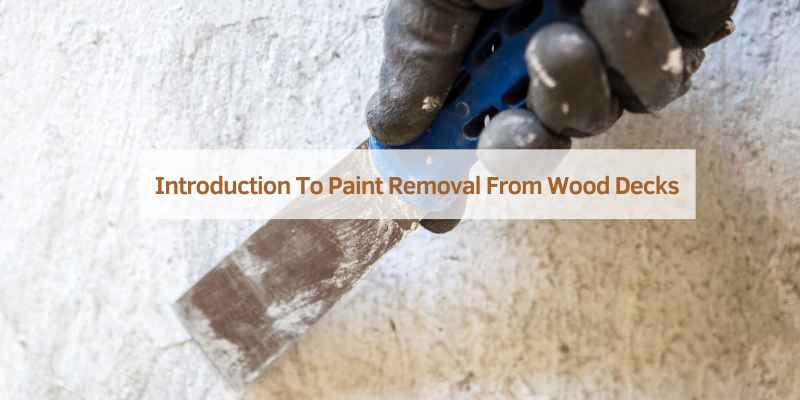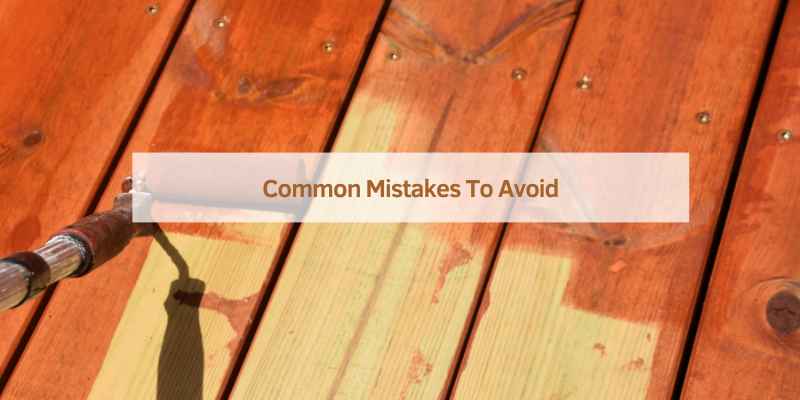To remove paint from a wood deck, use a paint stripper and a pressure washer. Apply the stripper, let it sit, then wash off with the pressure washer.
Maintaining the natural beauty of a wood deck often involves removing old paint or stain. Over time, these coatings can chip, fade, or peel, detracting from the deck’s appearance. Whether you want to refinish the wood or go back to its original state, knowing how to effectively remove paint from a wood deck is essential.
In this guide, we will explore the steps and tools needed to successfully strip paint from your wood deck, restoring its natural charm and beauty.
Introduction To Paint Removal From Wood Decks
Removing paint from a wood deck is an essential part of deck maintenance. Over time, layers of paint can chip, peel, and fade, detracting from the deck’s aesthetic appeal. By learning how to effectively remove paint from a wood deck, you can revitalize its appearance and prolong its lifespan. In this guide, we’ll explore the reasons for paint removal, the challenges involved, and effective methods for restoring your wood deck to its natural beauty.
Why Remove Paint?
Paint removal from a wood deck is necessary for several reasons. First, old, flaking paint can compromise the deck’s integrity, leading to wood rot and structural damage. Second, removing old layers of paint allows for better adhesion of new finishes, ensuring a longer-lasting and more attractive result. Third, restoring the deck to its natural wood state can enhance its beauty and provide a blank canvas for various staining or finishing options.
Challenges In Removing Paint From Wood Decks
While removing paint from a wood deck can be a rewarding process, it comes with its own set of challenges. One common challenge is the presence of multiple paint layers, which may require thorough stripping and sanding for complete removal. Another challenge is the use of harsh chemicals and equipment, which must be handled with care to avoid damage to the wood and surrounding environment. Lastly, the uneven application of paint and its penetration into wood grain can make complete removal a meticulous task.

Preparation Steps Before Starting
Before you start the process of removing paint from your wood deck, it’s crucial to prepare properly. Taking the time to get the right safety gear and tools, and inspecting the condition of the wood deck, will ensure a smooth and successful paint removal process. Let’s look at the essential preparation steps to follow before starting.
Safety Gear And Tools Needed
Ensuring you have the appropriate safety gear and tools is essential before tackling a paint removal project. Here’s a list of the necessary items:
- Dust mask
- Safety goggles
- Gloves
- Protective clothing
- Paint scraper or putty knife
- Wire brush
- Sandpaper
- Paint stripper or remover
- Pressure washer (optional)
Inspecting The Wood Deck Condition
Prior to starting the paint removal process, it’s important to inspect the condition of the wood deck. Look for any signs of rot, damage, or loose boards. Ensure the wood is in good condition and can withstand the paint removal process without causing further harm to the deck.
Chemical Paint Strippers: When And How To Use
Chemical paint strippers are an effective solution for removing paint from a wood deck. Follow the instructions carefully to ensure proper usage and achieve the desired results. Protect yourself with gloves and goggles, and apply the stripper evenly with a brush or roller.
Allow it to sit for the recommended time before scraping off the softened paint.
When it comes to removing paint from a wood deck, chemical paint strippers are a popular option. They can be very effective in removing even the toughest paint stains from your deck. However, it is important to choose the right type of stripper and use it correctly to ensure the best results. In this article, we will discuss how to choose the right chemical stripper and application techniques and tips.
Choosing The Right Chemical Stripper
Choosing the right chemical stripper for your deck depends on several factors, including the type of paint, age of the paint, and the type of wood. There are two main types of chemical strippers: solvent-based and water-based. Solvent-based strippers are more powerful and work faster, but they are also more toxic and can damage the wood. Water-based strippers are safer and less toxic, but they may take longer to work.
Application Techniques And Tips
Before applying the stripper, it is important to prepare your deck by cleaning it thoroughly and removing any loose or peeling paint. Once the surface is clean and dry, you can apply the stripper using a brush or roller. Be sure to wear protective gloves and clothing and work in a well-ventilated area.
When applying the stripper, it is important to work in small sections and apply a thick, even coat. You may need to apply more than one coat, depending on the thickness of the paint. After applying the stripper, let it sit for the recommended amount of time, usually around 30 minutes.
Once the stripper has worked its magic, you can begin removing the paint using a scraper or pressure washer. Be sure to follow the manufacturer’s instructions and use the appropriate tools for your specific deck.
In conclusion, chemical paint strippers can be a great option for removing paint from a wood deck. By choosing the right type of stripper and using the appropriate application techniques and tips, you can achieve excellent results and restore your deck to its former glory.
Heat Gun Method: A Controlled Approach
When it comes to removing paint from a wood deck, the heat gun method offers a controlled approach that is effective and efficient. By using a heat gun, you can soften the paint on the deck surface, making it easier to scrape off without causing damage to the wood underneath.
Selecting The Appropriate Heat Gun
Choose a heat gun with adjustable temperature settings to control the heat level based on the paint type.
Step-by-step Heat Application
- Start heat gun on low setting to avoid scorching the wood.
- Hold heat gun 6-8 inches away from the paint surface.
- Move the heat gun back and forth over the paint until it softens.
- Use a paint scraper to gently remove softened paint layers.
- Repeat the process until all paint is removed.
Sanding: Getting Down To The Grain
When it comes to removing paint from a wood deck, sanding is an essential step that helps you achieve a smooth and clean surface. Sanding not only removes the old paint but also prepares the wood for a fresh coat of paint or stain. In this section, we will explore the sanding process, including the types of sanders and sandpaper you can use.
Types Of Sanders And Sandpaper
Before you begin sanding your wood deck, it’s important to choose the right sander and sandpaper for the job. Here are a few options to consider:
| Sander Type | Best for |
|---|---|
| Belt sander | Large surface areas and heavy-duty sanding |
| Orbital sander | General sanding and smoothing |
| Random orbital sander | Faster sanding with less risk of swirl marks |
Once you’ve chosen the right sander, it’s time to select the appropriate sandpaper grit. For removing paint, start with a coarse grit sandpaper, such as 40 or 60, to effectively remove the paint layers. As you progress, switch to finer grits like 80 or 120 to smoothen the wood surface.
The Sanding Process
Now that you have your sander and sandpaper ready, follow these steps to effectively remove paint from your wood deck:
- Clean the deck: Before sanding, make sure the deck is free from any dirt, debris, or loose paint. Use a broom or a pressure washer to clean the surface.
- Start with coarse grit sandpaper: Attach the coarse grit sandpaper to your sander and begin sanding the deck. Move the sander in the direction of the wood grain, applying even pressure.
- Smooth out the surface: Once the majority of the paint is removed, switch to a finer grit sandpaper and sand the deck again. This will help to smooth out any remaining rough patches.
- Inspect for paint remnants: After sanding, inspect the deck for any remaining paint. Use a scraper or sandpaper to remove any stubborn spots.
- Clean the deck again: Finally, clean the deck once more to remove any dust or debris left behind from the sanding process.
Remember to wear protective gear, such as safety goggles and a dust mask, when sanding to avoid inhaling any harmful particles. Sanding can be a dusty process, so it’s important to work in a well-ventilated area and take necessary precautions.
By following these sanding steps, you’ll be well on your way to removing paint from your wood deck and achieving a smooth and ready-to-paint surface. Once the sanding is complete, you can proceed with the next steps of refinishing your deck to restore its beauty and protect it for years to come.
Power Washing: Fast And Messy
Power washing is a quick but messy way to remove paint from a wood deck.
Setting Up The Power Washer
1. Place the power washer on a stable surface near the deck.
2. Connect the water supply and ensure the power source is ready.
Effective Power Washing Techniques
1. Begin by holding the power washer nozzle a few feet away from the deck surface.
2. Move the nozzle back and forth in smooth, overlapping strokes.
3. Adjust the pressure settings to prevent damage to the wood.
4. Work systematically to cover the entire deck surface evenly.
Natural Solutions: Eco-friendly Alternatives
Discover natural solutions for eco-friendly paint removal on your wood deck. Explore gentle methods using vinegar, baking soda, or citrus-based solvents for a sustainable approach. Protect your deck while being kind to the environment with these effective alternatives.
If you’re looking for a more eco-friendly way to remove paint from your wood deck, you’re in luck. There are several natural solutions that can be just as effective as traditional paint removers. Here are a few homemade options you can try out:
Vinegar and Baking Soda Method
One of the most popular natural solutions for removing paint from wood is the vinegar and baking soda method. This method is easy to use and requires just a few common household items.
To begin, mix equal parts vinegar and water in a spray bottle. Next, sprinkle baking soda onto the painted areas of your deck. Spray the vinegar and water mixture onto the baking soda until it starts to fizz. Allow the mixture to sit on the paint for about 30 minutes before scrubbing it off with a stiff-bristled brush.
Other Homemade Paint Removers
If the vinegar and baking soda method doesn’t work for you, there are several other homemade paint removers you can try out. Here are a few options:
– Heat Gun: A heat gun can be used to soften the paint, making it easier to remove with a scraper.
– Citrus Solvent: Citrus solvent is a natural solvent that can be used to break down the paint. Simply apply the solvent to the painted area and let it sit for about 30 minutes before scrubbing it off.
– Soy Gel: Soy gel is a natural paint stripper that is made from soybeans. It is easy to use and can be applied with a brush or roller.
In conclusion, if you’re looking for a more eco-friendly way to remove paint from your wood deck, these natural solutions are a great place to start. Not only are they effective, but they are also safer for the environment and your health.
Finishing Touches: Post-paint Removal Care
After removing paint from a wood deck, it’s important to take care of it properly to maintain its appearance. Start by thoroughly cleaning the surface and then apply a wood brightener to restore its natural color. Finally, seal the deck with a protective coating to prevent future damage.
Cleaning And Neutralizing The Wood Deck
Once you have successfully removed the paint from your wood deck, it is essential to clean and neutralize the wood. The paint stripper and sanding process can leave behind residue that can affect the final outcome of your deck.
Begin by sweeping off any remaining debris and dust on the deck. Next, use a wood deck cleaner to remove any leftover paint stripper or sanding dust. Apply the cleaner as per instructions and scrub the deck with a stiff-bristled brush. Rinse the deck thoroughly with water and allow it to dry completely.
After cleaning, you must neutralize the wood to ensure that any remaining chemicals do not affect the final finish. Use a wood deck brightener to neutralize the surface. Apply the brightener as per instructions and scrub the deck with a stiff-bristled brush. Rinse the deck thoroughly with water and allow it to dry completely.
Sealing And Protecting The Wood
After cleaning and neutralizing, it is time to seal and protect the wood from the elements. Sealing the wood ensures that it does not absorb moisture, which can lead to rot and decay. Additionally, it helps to protect the wood from UV rays and other environmental factors.
Choose a high-quality wood deck sealer that is suitable for your deck’s wood type. Apply the sealer as per instructions using a paintbrush or a roller. Ensure that you apply the sealer evenly and cover all areas of the deck. Allow the sealer to dry completely before walking on the deck.
To maintain the protection of your deck, it is recommended to reapply the sealer every few years. This will help to keep the wood in good condition and extend the life of your deck.
In conclusion, taking care of your wood deck after removing paint is essential to ensure that it looks great and lasts long. Follow these simple steps to clean, neutralize, seal, and protect your deck, and you will have a beautiful outdoor space to enjoy for years to come.
Common Mistakes To Avoid
Ignoring Wood Type And Condition
Before starting, assess wood type and condition.
Overuse Of Chemicals Or Heat
Avoid excessive chemicals or heat to prevent damage.

Frequently Asked Questions
How Do I Remove Paint From A Wood Deck?
To remove paint from a wood deck, start by scraping off any loose paint using a putty knife or paint scraper. Then, apply a paint stripper or remover to the remaining paint, following the manufacturer’s instructions. Use a stiff brush or pressure washer to scrub away the softened paint.
Rinse thoroughly and allow the deck to dry before applying a new finish.
Can I Use A Power Washer To Remove Paint From My Wood Deck?
Yes, a power washer can be an effective tool for removing paint from a wood deck. Use a low-pressure setting and a wide-angle spray nozzle to avoid damaging the wood. Keep the nozzle at least 6-8 inches away from the surface and move it in a sweeping motion to evenly remove the paint.
Be cautious not to stay in one area for too long to prevent wood damage.
What Are Some Alternative Methods To Remove Paint From A Wood Deck?
If you prefer not to use chemicals or a power washer, there are alternative methods to remove paint from a wood deck. You can try sanding the deck using a coarse-grit sandpaper or a sanding machine. Another option is using a heat gun to soften the paint and scrape it off.
However, these methods may require more time and effort compared to chemical or power washing methods.
Conclusion
Removing paint from a wood deck requires patience and the right tools. By following the steps outlined in this guide, you can effectively restore the natural beauty of your deck. Remember to prioritize safety and take necessary precautions to protect the wood.
With the right approach, your deck can look as good as new.

